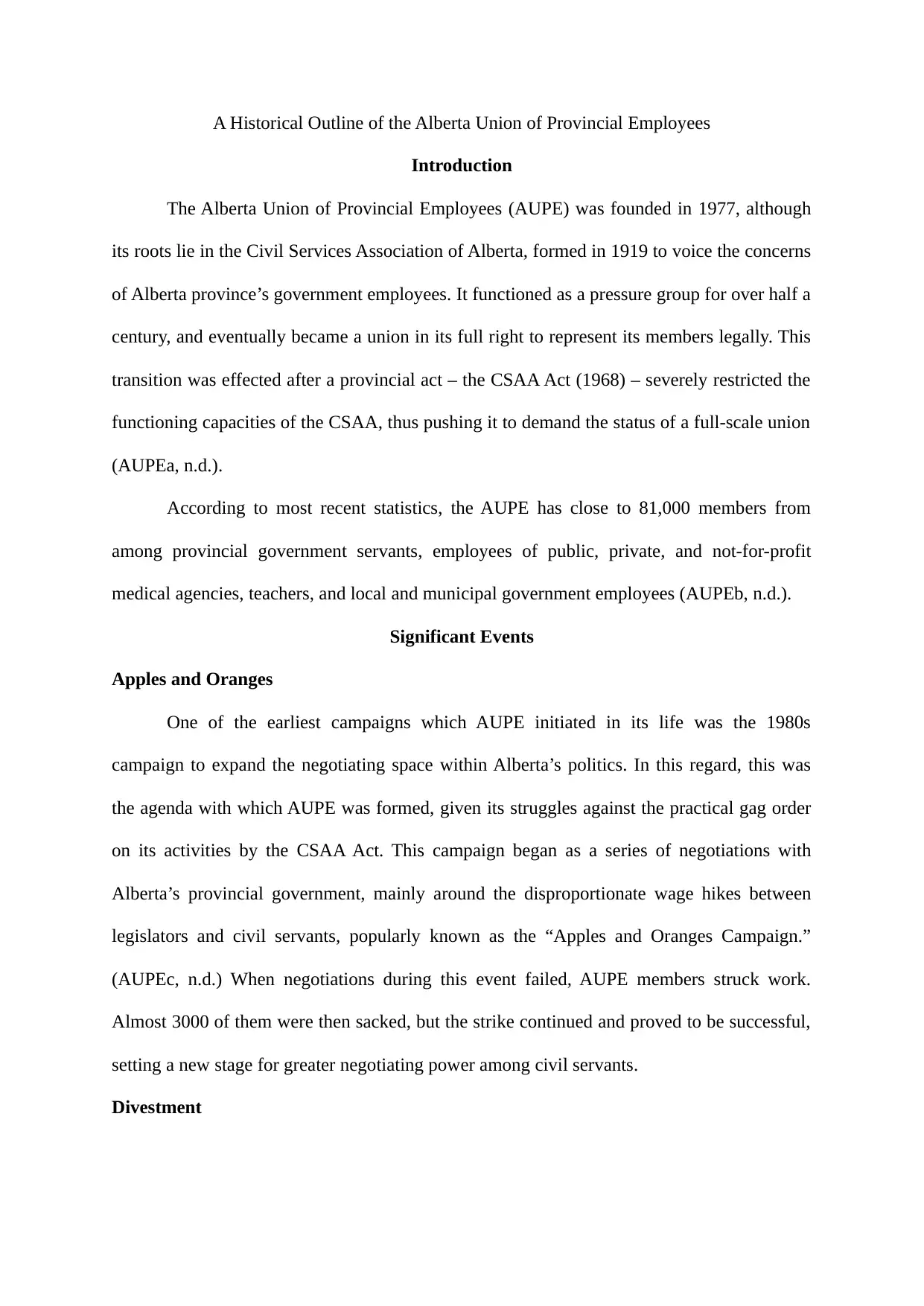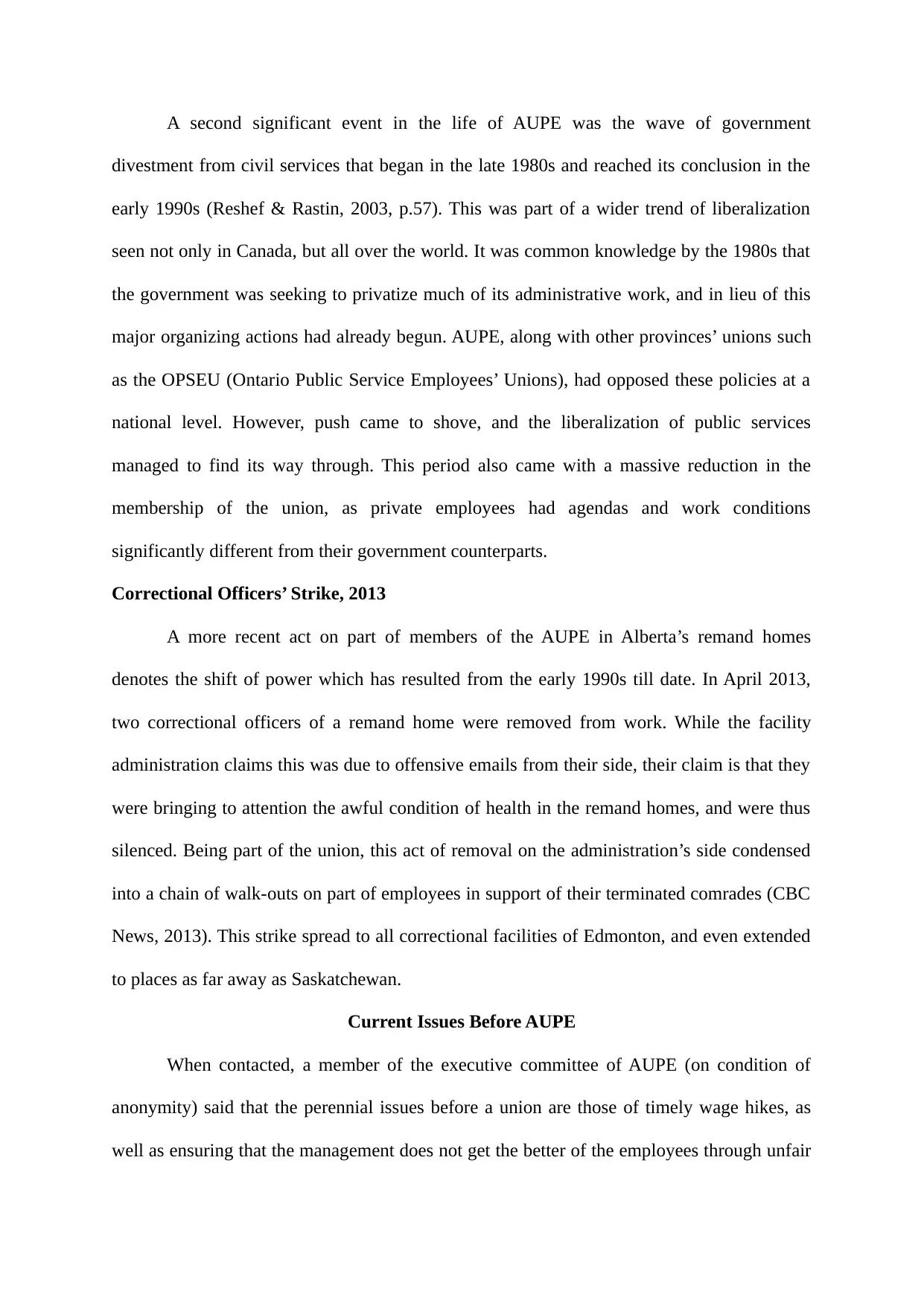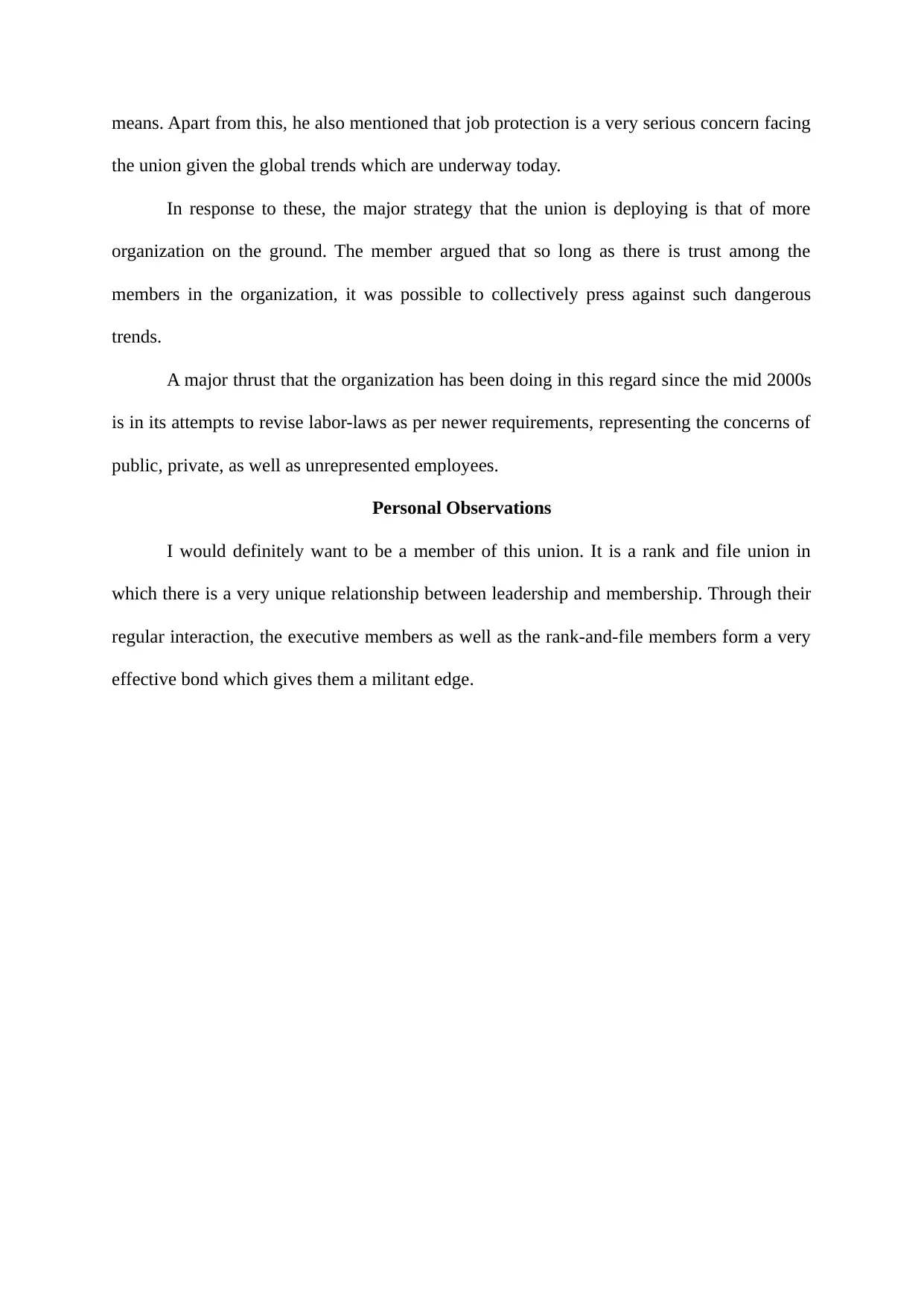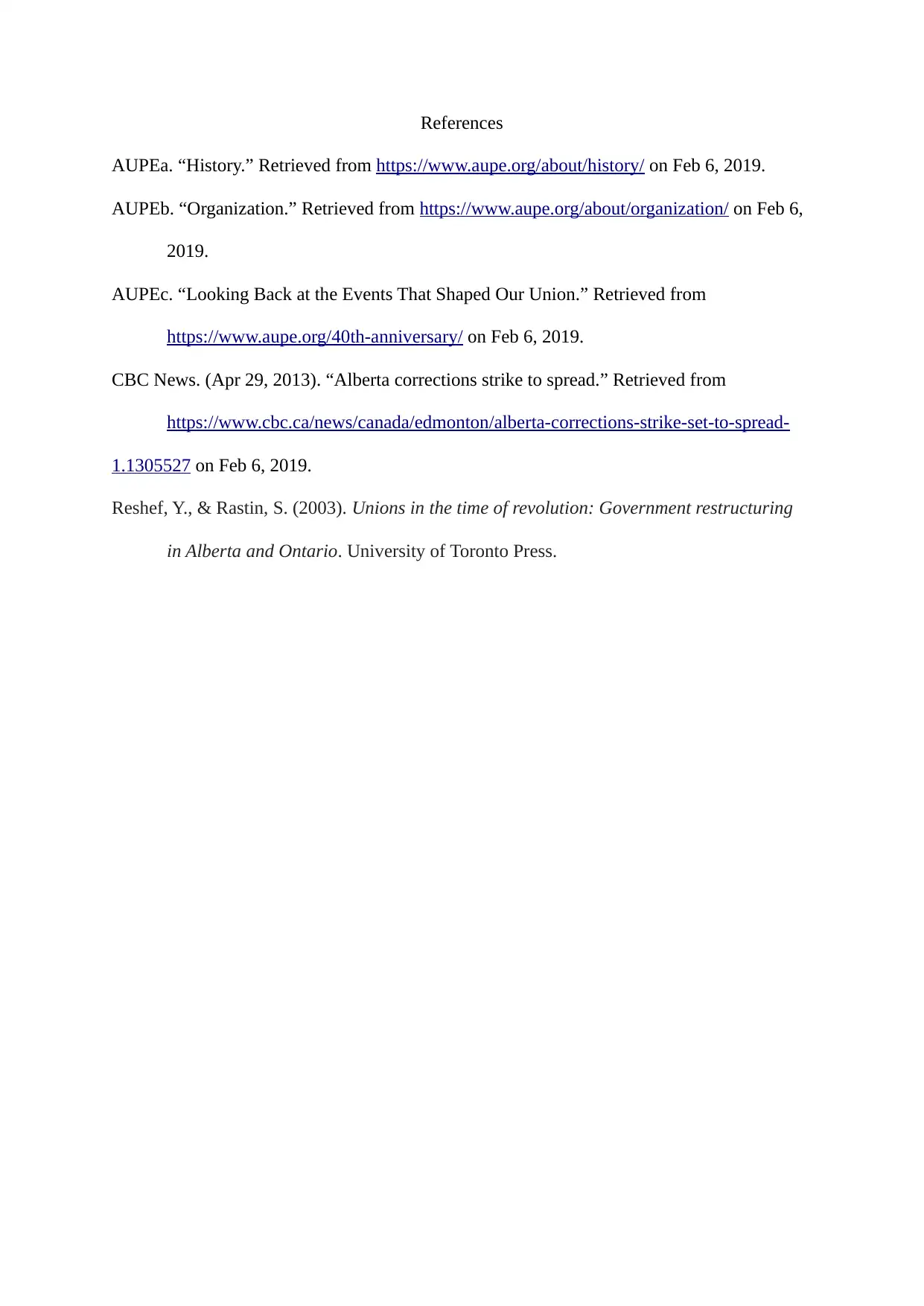The Alberta Union of Provincial Employees: A Detailed Historical Essay
VerifiedAdded on 2023/04/19
|4
|989
|270
Essay
AI Summary
This essay provides a historical outline of the Alberta Union of Provincial Employees (AUPE), tracing its roots from the Civil Services Association of Alberta in 1919 to its formal establishment as a union in 1977. It highlights significant events such as the "Apples and Oranges Campaign" in the 1980s, the challenges posed by government divestment in the late 1980s and early 1990s, and the Correctional Officers’ Strike in 2013. The essay also addresses current issues facing the AUPE, including wage negotiations, job protection, and the revision of labor laws, emphasizing the union's focus on grassroots organization and member trust. A personal observation is included, noting the unique relationship between leadership and membership within the union. The essay concludes with a list of references used.

A Historical Outline of the Alberta Union of Provincial Employees
Introduction
The Alberta Union of Provincial Employees (AUPE) was founded in 1977, although
its roots lie in the Civil Services Association of Alberta, formed in 1919 to voice the concerns
of Alberta province’s government employees. It functioned as a pressure group for over half a
century, and eventually became a union in its full right to represent its members legally. This
transition was effected after a provincial act – the CSAA Act (1968) – severely restricted the
functioning capacities of the CSAA, thus pushing it to demand the status of a full-scale union
(AUPEa, n.d.).
According to most recent statistics, the AUPE has close to 81,000 members from
among provincial government servants, employees of public, private, and not-for-profit
medical agencies, teachers, and local and municipal government employees (AUPEb, n.d.).
Significant Events
Apples and Oranges
One of the earliest campaigns which AUPE initiated in its life was the 1980s
campaign to expand the negotiating space within Alberta’s politics. In this regard, this was
the agenda with which AUPE was formed, given its struggles against the practical gag order
on its activities by the CSAA Act. This campaign began as a series of negotiations with
Alberta’s provincial government, mainly around the disproportionate wage hikes between
legislators and civil servants, popularly known as the “Apples and Oranges Campaign.”
(AUPEc, n.d.) When negotiations during this event failed, AUPE members struck work.
Almost 3000 of them were then sacked, but the strike continued and proved to be successful,
setting a new stage for greater negotiating power among civil servants.
Divestment
Introduction
The Alberta Union of Provincial Employees (AUPE) was founded in 1977, although
its roots lie in the Civil Services Association of Alberta, formed in 1919 to voice the concerns
of Alberta province’s government employees. It functioned as a pressure group for over half a
century, and eventually became a union in its full right to represent its members legally. This
transition was effected after a provincial act – the CSAA Act (1968) – severely restricted the
functioning capacities of the CSAA, thus pushing it to demand the status of a full-scale union
(AUPEa, n.d.).
According to most recent statistics, the AUPE has close to 81,000 members from
among provincial government servants, employees of public, private, and not-for-profit
medical agencies, teachers, and local and municipal government employees (AUPEb, n.d.).
Significant Events
Apples and Oranges
One of the earliest campaigns which AUPE initiated in its life was the 1980s
campaign to expand the negotiating space within Alberta’s politics. In this regard, this was
the agenda with which AUPE was formed, given its struggles against the practical gag order
on its activities by the CSAA Act. This campaign began as a series of negotiations with
Alberta’s provincial government, mainly around the disproportionate wage hikes between
legislators and civil servants, popularly known as the “Apples and Oranges Campaign.”
(AUPEc, n.d.) When negotiations during this event failed, AUPE members struck work.
Almost 3000 of them were then sacked, but the strike continued and proved to be successful,
setting a new stage for greater negotiating power among civil servants.
Divestment
Paraphrase This Document
Need a fresh take? Get an instant paraphrase of this document with our AI Paraphraser

A second significant event in the life of AUPE was the wave of government
divestment from civil services that began in the late 1980s and reached its conclusion in the
early 1990s (Reshef & Rastin, 2003, p.57). This was part of a wider trend of liberalization
seen not only in Canada, but all over the world. It was common knowledge by the 1980s that
the government was seeking to privatize much of its administrative work, and in lieu of this
major organizing actions had already begun. AUPE, along with other provinces’ unions such
as the OPSEU (Ontario Public Service Employees’ Unions), had opposed these policies at a
national level. However, push came to shove, and the liberalization of public services
managed to find its way through. This period also came with a massive reduction in the
membership of the union, as private employees had agendas and work conditions
significantly different from their government counterparts.
Correctional Officers’ Strike, 2013
A more recent act on part of members of the AUPE in Alberta’s remand homes
denotes the shift of power which has resulted from the early 1990s till date. In April 2013,
two correctional officers of a remand home were removed from work. While the facility
administration claims this was due to offensive emails from their side, their claim is that they
were bringing to attention the awful condition of health in the remand homes, and were thus
silenced. Being part of the union, this act of removal on the administration’s side condensed
into a chain of walk-outs on part of employees in support of their terminated comrades (CBC
News, 2013). This strike spread to all correctional facilities of Edmonton, and even extended
to places as far away as Saskatchewan.
Current Issues Before AUPE
When contacted, a member of the executive committee of AUPE (on condition of
anonymity) said that the perennial issues before a union are those of timely wage hikes, as
well as ensuring that the management does not get the better of the employees through unfair
divestment from civil services that began in the late 1980s and reached its conclusion in the
early 1990s (Reshef & Rastin, 2003, p.57). This was part of a wider trend of liberalization
seen not only in Canada, but all over the world. It was common knowledge by the 1980s that
the government was seeking to privatize much of its administrative work, and in lieu of this
major organizing actions had already begun. AUPE, along with other provinces’ unions such
as the OPSEU (Ontario Public Service Employees’ Unions), had opposed these policies at a
national level. However, push came to shove, and the liberalization of public services
managed to find its way through. This period also came with a massive reduction in the
membership of the union, as private employees had agendas and work conditions
significantly different from their government counterparts.
Correctional Officers’ Strike, 2013
A more recent act on part of members of the AUPE in Alberta’s remand homes
denotes the shift of power which has resulted from the early 1990s till date. In April 2013,
two correctional officers of a remand home were removed from work. While the facility
administration claims this was due to offensive emails from their side, their claim is that they
were bringing to attention the awful condition of health in the remand homes, and were thus
silenced. Being part of the union, this act of removal on the administration’s side condensed
into a chain of walk-outs on part of employees in support of their terminated comrades (CBC
News, 2013). This strike spread to all correctional facilities of Edmonton, and even extended
to places as far away as Saskatchewan.
Current Issues Before AUPE
When contacted, a member of the executive committee of AUPE (on condition of
anonymity) said that the perennial issues before a union are those of timely wage hikes, as
well as ensuring that the management does not get the better of the employees through unfair

means. Apart from this, he also mentioned that job protection is a very serious concern facing
the union given the global trends which are underway today.
In response to these, the major strategy that the union is deploying is that of more
organization on the ground. The member argued that so long as there is trust among the
members in the organization, it was possible to collectively press against such dangerous
trends.
A major thrust that the organization has been doing in this regard since the mid 2000s
is in its attempts to revise labor-laws as per newer requirements, representing the concerns of
public, private, as well as unrepresented employees.
Personal Observations
I would definitely want to be a member of this union. It is a rank and file union in
which there is a very unique relationship between leadership and membership. Through their
regular interaction, the executive members as well as the rank-and-file members form a very
effective bond which gives them a militant edge.
the union given the global trends which are underway today.
In response to these, the major strategy that the union is deploying is that of more
organization on the ground. The member argued that so long as there is trust among the
members in the organization, it was possible to collectively press against such dangerous
trends.
A major thrust that the organization has been doing in this regard since the mid 2000s
is in its attempts to revise labor-laws as per newer requirements, representing the concerns of
public, private, as well as unrepresented employees.
Personal Observations
I would definitely want to be a member of this union. It is a rank and file union in
which there is a very unique relationship between leadership and membership. Through their
regular interaction, the executive members as well as the rank-and-file members form a very
effective bond which gives them a militant edge.
⊘ This is a preview!⊘
Do you want full access?
Subscribe today to unlock all pages.

Trusted by 1+ million students worldwide

References
AUPEa. “History.” Retrieved from https://www.aupe.org/about/history/ on Feb 6, 2019.
AUPEb. “Organization.” Retrieved from https://www.aupe.org/about/organization/ on Feb 6,
2019.
AUPEc. “Looking Back at the Events That Shaped Our Union.” Retrieved from
https://www.aupe.org/40th-anniversary/ on Feb 6, 2019.
CBC News. (Apr 29, 2013). “Alberta corrections strike to spread.” Retrieved from
https://www.cbc.ca/news/canada/edmonton/alberta-corrections-strike-set-to-spread-
1.1305527 on Feb 6, 2019.
Reshef, Y., & Rastin, S. (2003). Unions in the time of revolution: Government restructuring
in Alberta and Ontario. University of Toronto Press.
AUPEa. “History.” Retrieved from https://www.aupe.org/about/history/ on Feb 6, 2019.
AUPEb. “Organization.” Retrieved from https://www.aupe.org/about/organization/ on Feb 6,
2019.
AUPEc. “Looking Back at the Events That Shaped Our Union.” Retrieved from
https://www.aupe.org/40th-anniversary/ on Feb 6, 2019.
CBC News. (Apr 29, 2013). “Alberta corrections strike to spread.” Retrieved from
https://www.cbc.ca/news/canada/edmonton/alberta-corrections-strike-set-to-spread-
1.1305527 on Feb 6, 2019.
Reshef, Y., & Rastin, S. (2003). Unions in the time of revolution: Government restructuring
in Alberta and Ontario. University of Toronto Press.
1 out of 4
Related Documents
Your All-in-One AI-Powered Toolkit for Academic Success.
+13062052269
info@desklib.com
Available 24*7 on WhatsApp / Email
![[object Object]](/_next/static/media/star-bottom.7253800d.svg)
Unlock your academic potential
Copyright © 2020–2025 A2Z Services. All Rights Reserved. Developed and managed by ZUCOL.





